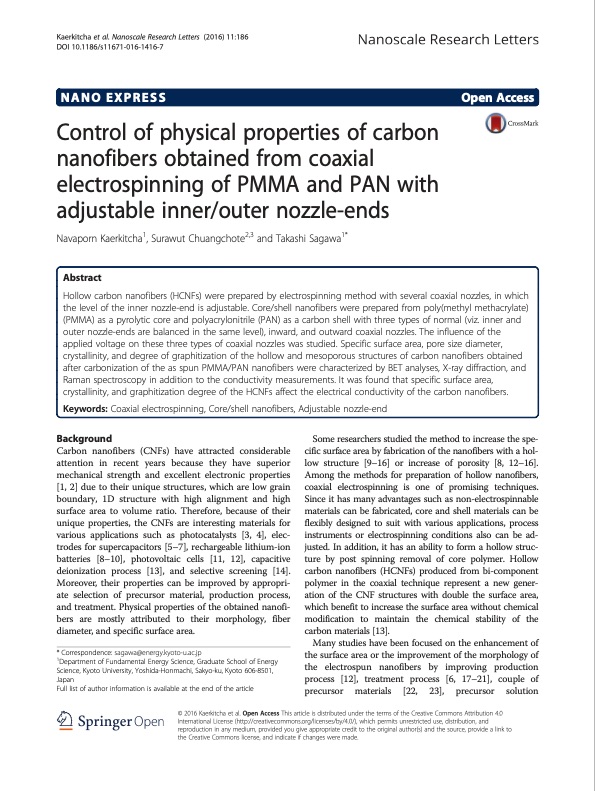
PDF Publication Title:
Text from PDF Page: 001
Kaerkitcha et al. Nanoscale Research Letters (2016) 11:186 DOI 10.1186/s11671-016-1416-7 NANO EXPRESS Control of physical properties of carbon nanofibers obtained from coaxial electrospinning of PMMA and PAN with adjustable inner/outer nozzle-ends Navaporn Kaerkitcha1, Surawut Chuangchote2,3 and Takashi Sagawa1* Abstract Open Access Hollow carbon nanofibers (HCNFs) were prepared by electrospinning method with several coaxial nozzles, in which the level of the inner nozzle-end is adjustable. Core/shell nanofibers were prepared from poly(methyl methacrylate) (PMMA) as a pyrolytic core and polyacrylonitrile (PAN) as a carbon shell with three types of normal (viz. inner and outer nozzle-ends are balanced in the same level), inward, and outward coaxial nozzles. The influence of the applied voltage on these three types of coaxial nozzles was studied. Specific surface area, pore size diameter, crystallinity, and degree of graphitization of the hollow and mesoporous structures of carbon nanofibers obtained after carbonization of the as spun PMMA/PAN nanofibers were characterized by BET analyses, X-ray diffraction, and Raman spectroscopy in addition to the conductivity measurements. It was found that specific surface area, crystallinity, and graphitization degree of the HCNFs affect the electrical conductivity of the carbon nanofibers. Keywords: Coaxial electrospinning, Core/shell nanofibers, Adjustable nozzle-end Background Carbon nanofibers (CNFs) have attracted considerable attention in recent years because they have superior mechanical strength and excellent electronic properties [1, 2] due to their unique structures, which are low grain boundary, 1D structure with high alignment and high surface area to volume ratio. Therefore, because of their unique properties, the CNFs are interesting materials for various applications such as photocatalysts [3, 4], elec- trodes for supercapacitors [5–7], rechargeable lithium-ion batteries [8–10], photovoltaic cells [11, 12], capacitive deionization process [13], and selective screening [14]. Moreover, their properties can be improved by appropri- ate selection of precursor material, production process, and treatment. Physical properties of the obtained nanofi- bers are mostly attributed to their morphology, fiber diameter, and specific surface area. * Correspondence: sagawa@energy.kyoto-u.ac.jp 1Department of Fundamental Energy Science, Graduate School of Energy Science, Kyoto University, Yoshida-Honmachi, Sakyo-ku, Kyoto 606-8501, Japan Full list of author information is available at the end of the article Some researchers studied the method to increase the spe- cific surface area by fabrication of the nanofibers with a hol- low structure [9–16] or increase of porosity [8, 12–16]. Among the methods for preparation of hollow nanofibers, coaxial electrospinning is one of promising techniques. Since it has many advantages such as non-electrospinnable materials can be fabricated, core and shell materials can be flexibly designed to suit with various applications, process instruments or electrospinning conditions also can be ad- justed. In addition, it has an ability to form a hollow struc- ture by post spinning removal of core polymer. Hollow carbon nanofibers (HCNFs) produced from bi-component polymer in the coaxial technique represent a new gener- ation of the CNF structures with double the surface area, which benefit to increase the surface area without chemical modification to maintain the chemical stability of the carbon materials [13]. Many studies have been focused on the enhancement of the surface area or the improvement of the morphology of the electrospun nanofibers by improving production process [12], treatment process [6, 17–21], couple of precursor materials [22, 23], precursor solution © 2016 Kaerkitcha et al. Open Access This article is distributed under the terms of the Creative Commons Attribution 4.0 International License (http://creativecommons.org/licenses/by/4.0/), which permits unrestricted use, distribution, and reproduction in any medium, provided you give appropriate credit to the original author(s) and the source, provide a link to the Creative Commons license, and indicate if changes were made.PDF Image | carbon nanofibers obtained from coaxial electrospinning

PDF Search Title:
carbon nanofibers obtained from coaxial electrospinningOriginal File Name Searched:
s11671-016-1416-7.pdfDIY PDF Search: Google It | Yahoo | Bing
Sulfur Deposition on Carbon Nanofibers using Supercritical CO2 Sulfur Deposition on Carbon Nanofibers using Supercritical CO2. Gamma sulfur also known as mother of pearl sulfur and nacreous sulfur... More Info
CO2 Organic Rankine Cycle Experimenter Platform The supercritical CO2 phase change system is both a heat pump and organic rankine cycle which can be used for those purposes and as a supercritical extractor for advanced subcritical and supercritical extraction technology. Uses include producing nanoparticles, precious metal CO2 extraction, lithium battery recycling, and other applications... More Info
| CONTACT TEL: 608-238-6001 Email: greg@infinityturbine.com | RSS | AMP |